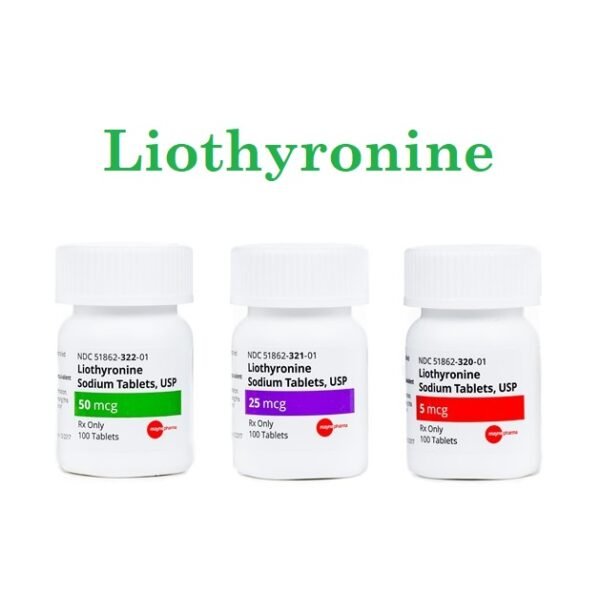Liothyronine (T3) is used in the treatment of patients with hypothyroidism and myxedema coma. Liothyronine has a shorter duration of action compared to levothyroxine (T4) and is, therefore, less preferred in the chronic management of hypothyroidism. However, in the emergency settings, such as in patients with myxedema coma, Liothyronine is used as an adjunct to Levothyroxine (T4).
Liothyronine Uses:
-
Thyroid disorders:
- Oral: Used as replacement therapy in primary (thyroidal), secondary (pituitary), and tertiary (hypothalamic) congenital or acquired hypothyroidism; also an adjunctive therapy to surgery and radioiodine therapy in the management of well-differentiated thyroid cancer & a diagnostic agent in suppression tests for differentiation of suspected mild hyperthyroidism or thyroid gland autonomy.
-
Limitations of use:
- In iodine-sufficient patients, it is not indicated for suppression of benign thyroid nodules and nontoxic diffuse goiter.
- Not to be used for the treatment of hypothyroidism during the recovery phase of subacute thyroiditis.
-
Myxedema coma/precoma:
- IV: Used for treating myxedema coma/precoma
Note: In patients allergic to desiccated thyroid or thyroid extract derived from pork or beef, it may be used.
-
Off Label Use of Liothyronine in Adults:
- Antidepressant augmentation
- Organ recovery for a cadaver (hormonal resuscitation)
- To prevent memory deficit with electroconvulsive therapy (ECT)
Liothyronine Dose in Adults:
Liothyronine Dose in the treatment of Hypothyroidism: Oral:
- Initial: 25 mcg once a day; dose may be increased by up to 25 mcg/day every 1 to 2 weeks; usual maintenance dose: 25 to 75 mcg once a day
-
Patients with cardiovascular disease:
- Initial: 5 mcg once a day daily; dose may be increased by 5 mcg/day every 2 weeks.
-
Conversion to liothyronine from thyroid (desiccated) or levothyroxine:
- The other medication should be discontinued, a low dose of liothyronine should be started and increased gradually according to response. Liothyronine's onset of action is rapid; residual effects of other thyroid preparation may persist for the first several weeks into therapy.
-
Liothyronine Dose in the treatment of Myxedema coma: IV:
-
Adjunctive therapy in combination with levothyroxine:
- Initial: A loading dose of 5 to 20 mcg; maintenance: 2.5 to 10 mcg thrice a day; therapy should be continued as clinically indicated. Consider lower dosages for patients who are small, elderly, or have coronary artery disease or arrhythmia. High doses should be avoided due to risks associated with high serum triiodothyronine levels (ATA [Jonklaas 2014]).
Note: Normally, at least 4 hours should be allowed between IV doses for adequate assessment of therapeutic response, and allow no more than 12 hours to elapse between doses to avoid fluctuations in hormone levels. Resume oral therapy as soon as the clinical situation has been stabilized and the patient is able to take oral medication. If levothyroxine rather than liothyronine sodium is used in initiating oral therapy, the prescriber should bear in mind that there is a delay of several days in the onset of levothyroxine activity and that IV therapy should be gradually discontinued.
-
Conversion to liothyronine tablets from injectable liothyronine:
- The injectable should be discontinued and oral therapy should be initiated at a low dosage and should be gradually increased according to the response.
Liothyronine Dose in the Suppression test (T ):
- Oral: 75 to 100 mcg OD for 1 week. Determine radioactive iodide uptake before and after administration.
Liothyronine Dose in the Antidepressant augmentation (off-label):
- Oral: Initial: 25 mcg per 24 hours; may be increased to 50 mcg per 24 hours after ~1 week according to response and tolerability. Dose ranges of 20 to 62.5 mcg per 24 hours have been studied in clinical trials.
- Note: Proper studies are not available for the duration of treatment. If there is a history of multiple episodes or significant treatment resistance, it is reasonable to institute long-term maintenance treatment if there are no symptoms of hyperthyroidism and no known cardiac disease.
Liothyronine Dose in the treatment of Cadaveric organ recovery (hormonal resuscitation) (off-label):
- IV: Initial: Administer 4 mcg bolus followed by a continuous infusion of 3 mcg/hour to the brain-dead donor who is hemodynamically unstable and there is a requirement of significant vasopressor support; should be given concomitantly with vasopressin, methylprednisolone, and continuous regular insulin infusion (maintain blood glucose 120 to 180 mg/dL).
Liothyronine Dose in the Prevention of memory deficit with ECT (off-label):
- Oral: 50 mcg per 24 hours is administered from the day before the beginning of ECT and every morning until the last session. To further define the role of liothyronine in this setting additional data may be required.
Liothyronine Dose in Childrens:
Liothyronine Dose in the treatment of Congenital hypothyroidism:
Note: According to guidelines the routine use of liothyronine over levothyroxine monotherapy is not recommended in the management of hypothyroidism.
-
Infants, Children, and Adolescents:
- Oral: Initial: 5 mcg/day; increase by 5 mcg every 3 to 4 days
-
Usual maintenance dose:
- Infants: 20 mcg per 24 hours
- Children 1 to 3 years: 50 mcg per 24 hours
- Children >3 years and Adolescents: 25 to 75 mcg per 24 hours
Pregnancy Risk Category: B
- The risk of teratogenicity and adverse effects from maternal use during pregnancy is not increased.
- Uncontrolled maternal hypothyroidism can lead to adverse maternal and neonatal outcomes.
- Prevent adverse events by maintaining normal maternal thyroid function before conception and throughout pregnancy.
- Levothyroxine can be used to control hypothyroidism in pregnancy.
Use during breastfeeding:
- Breast milk contains liothyronine.
- According to the manufacturer, it is important to consider these factors when deciding whether or not to breastfeed during therapy.
- Infant exposure is a risk
- Breastfeeding is good for the infant
- Mothers can reap the benefits of mother-to-child treatment
Dose in Kidney Disease:
No dosage adjustments have been provided in the manufacturer’s labeling; use cautiously. Liothyronine undergoes substantial renal excretion.
Dose in Liver disease:
No dosage adjustments have been provided in the manufacturer’s labeling.
Side Effects of Liothyronine:
-
Cardiovascular:
- Cardiac arrhythmia
- Tachycardia
- Hypotension
- Myocardial infarction
Contraindications to Liothyronine:
Injection:
- Hypersensitivity to liothyronine salt or any other component of the formulation
- Uncorrected adrenal Insufficiency
- Thyrotoxicosis untreated
- Use of artificial rewarming in conjunction with the patient
Oral:
- Untreated adrenal insufficiency
Canadian labeling: Additional contraindications:
- Acute myocardial injury
Warnings and precautions
-
Insufficiency of the adrenal glands:
- Avoid using adrenal insufficiency. It can exaggerate symptoms or worsen them.
- Patients with adrenal insufficiency should receive glucocorticoids before receiving thyroid replacement therapy.
- It is not recommended for patients suffering from uncorrected adrenal dysfunction.
-
Cardiovascular disease
- Take care. Patients with angina pectoris and other cardiovascular diseases should reduce the dosage.
- Chronic hypothyroidism can lead to coronary artery disease.
-
Diabetes:
- Diabetes mellitus patients should be cautious as this could lead to a worsening of the glycemic control.
-
Myxedema
- Myxedema can be exaggerated or aggravated by this medication.
- The first dose of therapy should be low and gradually increased.
- For myxedema coma, injectable thyroid hormone replacement products should be administered intravenously.
-
Osteoporosis
- A decrease in bone mineral density can be caused by long-term therapy.
- Postmenopausal women should use the lowest dose for clinical response. This is also true for women who are taking suppressive doses.
Liothyronine: Drug Interaction
|
Amezinium |
Thyroid Products may enhance the stimulatory effect of Amezinium. |
|
Amiodarone |
May diminish the therapeutic effect of Thyroid Products. |
|
Apalutamide |
May diminish the therapeutic effect of Thyroid Products. |
|
CarBAMazepine |
May decrease the serum concentration of Thyroid Products. |
|
Ciprofloxacin (Systemic) |
May decrease the serum concentration of Thyroid Products. |
|
Estrogen Derivatives |
May diminish the therapeutic effect of Thyroid Products. |
|
Fosphenytoin |
May decrease the serum concentration of Thyroid Products. Phenytoin may also displace thyroid hormones from protein binding sites. |
|
Phenytoin |
May decrease the serum concentration of Thyroid Products. Phenytoin may also displace thyroid hormones from protein binding sites. |
|
Piracetam |
May enhance the adverse/toxic effect of Thyroid Products. Specifically, symptoms including confusion, irritability, and sleep disorder have been described during concomitant use. |
|
RifAMPin |
May decrease the serum concentration of Thyroid Products. |
|
Ritonavir |
May diminish the therapeutic effect of Thyroid Products. |
|
Selective Serotonin Reuptake Inhibitors |
May diminish the therapeutic effect of Thyroid Products. Thyroid product dose requirements may be increased. |
|
Theophylline Derivatives |
Thyroid Products may increase the metabolism of Theophylline Derivatives. Exceptions: Dyphylline. |
|
Tricyclic Antidepressants |
Thyroid Products may enhance the arrhythmogenic effect of Tricyclic Antidepressants. Thyroid Products may enhance the stimulatory effect of Tricyclic Antidepressants. |
|
Vitamin K Antagonists (eg, warfarin) |
Thyroid Products may enhance the anticoagulant effect of Vitamin K Antagonists. |
|
Bile Acid Sequestrants |
May decrease the serum concentration of Thyroid Products. Management: Administer oral thyroid products at least 4 h prior to colesevelam, and at least 1 h before or 4-6 h after cholestyramine. Specific recommendations for colestipol are not available. Monitor for decreased concentrations/effects of the thyroid product. |
|
Calcium Polystyrene Sulfonate |
May decrease the serum concentration of Thyroid Products. Management: To minimize risk of interaction, separate dosing of oral calcium polystyrene sulfonate and thyroid products (eg, levothyroxine) or administer calcium polystyrene sulfonate rectally. Monitor for signs/symptoms of hypothyroidism with concomitant use (oral). |
|
Calcium Salts |
May diminish the therapeutic effect of Thyroid Products. Management: Separate the doses of the thyroid product and the oral calcium supplement by at least 4 hours. |
|
Lanthanum |
May decrease the serum concentration of Thyroid Products. Management: Administer oral thyroid products at least two hours before or after lanthanum. |
|
Sodium Polystyrene Sulfonate |
May decrease the serum concentration of Thyroid Products. Management: To minimize risk of interaction, separate dosing of oral sodium polystyrene sulfonate and thyroid products (e.g., levothyroxine) or administer sodium polystyrene sulfonate rectally. Monitor for signs/symptoms of hypothyroidism with concomitant use (oral). |
|
Sodium Iodide I131 |
Thyroid Products may diminish the therapeutic effect of Sodium Iodide I131. |
Monitoring parameters:
- TSH (4 to 6 weeks after initiation of treatment or change in dose, 4 to 6 months after adequate replacement dose determined, followed by every 1 yearly thereafter (or more frequently depending on the clinical situation)
- Pulse rate & blood pressure
- Clinical signs of hypo- and hyperthyroidism
Note: The most reliable guide for evaluating the adequacy of thyroid replacement dosage in primary thyroid dysfunction is TSH; however, in patients with central hypothyroidism, measuring TSH is not adequate to guide treatment.
- Bone mineral density (particularly with long term therapy in postmenopausal women).
Antidepressant augmentation (off-label use): Adults:
- Free T4, free T3, and TSH (baseline, recheck at 12 weeks, and then every half-yearly to 1 year at minimum).
- TSH level should be at least at the lower limit of the normal range [~0.4 milliunits/ml] or below in the absence of hyperthyroid symptoms; free T3 can be maintained at the upper limit of the normal range based on the severity of depressive symptoms and response to T3.
How to administer Liothyronine?
IV: Only for intravenous use; not to be given IM or SubQ
Intermittent IV administration: Should be administered at a rate of 10 mcg/minute.
Continuous IV infusion:
- Cadaveric organ recovery (hormonal resuscitation) (off-label use):
- May administer as a continuous infusion after the IV bolus dose.
Mechanism of action of Liothyronine:
- The exact mechanism of action of thyroid hormone is unknown.
- However, it is believed that it exerts its many metabolic effects by controlling the DNA transcription and protein synthesizing.
- This is important for normal metabolism and growth and development. It also promotes gluconeogenesis.
Onset of action
- Oral administration: The onset of action can be achieved in a matter of hours.
Peak response
- Peak response with oral administration occurs within 2 to 3 days
Absorption
- When given orally, : 95% of the contents are well absorbed
Half-life elimination:
- 0.75 days
Excretion:
- Primarily via urine
- Feces
International Brand Names of Liothyronine:
- Cytomel
- Triostat
- Cynomel
- Cytomel
- Cytomel 25
- Dispon
- Halotri
- Iobolin
- Liothyronin
- Liotir
- Neo-Tiroimade
- T3
- Tertroxin
- Tetronine
- Thybon Henning
- Thyronine
- Thyrotardin inject.
- Ti-Tre
- Tiromel
- Tri-Iodo-Tironina
- Trijodthyronin
- Trijodthyronin BC
- Triyodotironina
- Triyotex
Liothyronine Brand Names in Pakistan:
No Brands Available in Pakistan.




